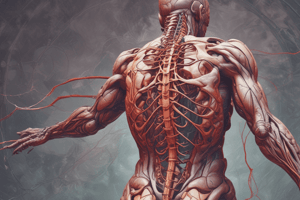Podcast
Questions and Answers
What primarily composes a visceral skeleton?
What primarily composes a visceral skeleton?
- Chitin and keratin
- Muscle fibers and connective tissue
- Spicules, sclerites, or plates of hard materials (correct)
- Cartilage and bone
Which function is NOT associated with a visceral skeleton?
Which function is NOT associated with a visceral skeleton?
- Providing structural support to internal organs
- Serving as a hard outer covering (correct)
- Maintaining body shape and form
- Protecting sensitive organs
Which type of organism is most likely to possess a visceral skeleton?
Which type of organism is most likely to possess a visceral skeleton?
- Birds with avian skeletal structures
- Echinoderms like sea stars and sea urchins (correct)
- Mammals with bony skeletons
- Insects with chitinous exoskeletons
How does a visceral skeleton differ from an endoskeleton?
How does a visceral skeleton differ from an endoskeleton?
What evolutionary advantage does a visceral skeleton provide?
What evolutionary advantage does a visceral skeleton provide?
Which of the following organisms does NOT exhibit a visceral skeleton?
Which of the following organisms does NOT exhibit a visceral skeleton?
Which statement accurately describes the nature of a visceral skeleton?
Which statement accurately describes the nature of a visceral skeleton?
What is true about the rigidity of visceral skeletons?
What is true about the rigidity of visceral skeletons?
Flashcards
Visceral Skeleton
Visceral Skeleton
An internal support structure found in some invertebrates, providing support and protection for internal organs.
Spicules
Spicules
Tiny, hard structures that make up a visceral skeleton. Can be made of calcium carbonate or other materials.
Exoskeleton
Exoskeleton
A hard, outer covering that provides support and protection for the organism.
Endoskeleton
Endoskeleton
Signup and view all the flashcards
Function of the Visceral Skeleton
Function of the Visceral Skeleton
Signup and view all the flashcards
Evolutionary Significance of the Visceral Skeleton
Evolutionary Significance of the Visceral Skeleton
Signup and view all the flashcards
Visceral Skeleton in Cnidaria
Visceral Skeleton in Cnidaria
Signup and view all the flashcards
Evolution of Visceral Skeletons
Evolution of Visceral Skeletons
Signup and view all the flashcards
Study Notes
Introduction
- A visceral skeleton is a type of endoskeleton found in some invertebrates.
- It differs from the more familiar exoskeleton and the more common endoskeleton.
- It's typically found in soft-bodied invertebrates, offering internal support and protection.
Structure and Composition
- Composed mainly of spicules, sclerites, or plates of calcium carbonate or other hard materials.
- These materials are embedded within the organism's soft tissues.
- The structure and composition vary considerably depending on the animal and its evolutionary lineage.
- The rigidity also varies between species.
Function
- Provides structural support, especially to internal organs.
- Helps maintain the organism's shape and form.
- Can act as a protective layer for delicate organs.
- Sometimes plays a role in locomotion or other specialized functions.
Examples of Animals with Visceral Skeletons
- Echinoderms (sea stars, sea urchins) have a complex internal skeleton made of interlocking plates or ossicles.
- Some mollusks (bivalves, gastropods) have an internal support structure of calcium carbonate.
- Sponges often have a visceral skeleton composed of spicules and fibers.
- Coral, though having a calcium carbonate exoskeleton, is not an example of a creature with a visceral skeleton, as the support structure is external, not internal.
Differences from Exoskeleton and Endoskeleton
- Exoskeletons are hard outer coverings, unlike the internal visceral skeletons.
- Endoskeletons, typically found in vertebrates and some invertebrates, are more complex, containing bones and cartilage. They often contain mineralized tissue, different from the materials found in visceral skeletons.
- Visceral skeletons are generally simpler in structure than endoskeletons.
Evolutionary Significance
- The evolution of a visceral skeleton represents an adaptation to accommodate developing internal organs and systems within the animal body.
- Their existence highlights the diverse skeletal support structures and adaptations in the animal kingdom.
Relation to Other Body Systems
- The visceral skeleton's structure and composition can interact with other systems, such as the nervous or circulatory systems.
- This interaction impacts the organism's overall function.
- The interplay between the visceral skeleton and other features is crucial for an organism's survival and function.
Studying That Suits You
Use AI to generate personalized quizzes and flashcards to suit your learning preferences.



